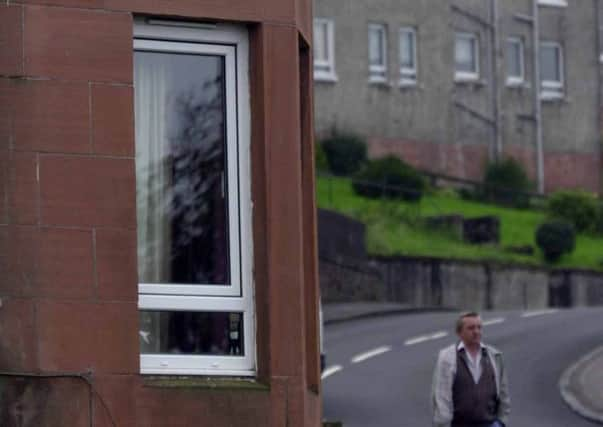Martyn McLaughlin: Deprivation a scourge that defies solutions


The stretch of water where the River Clyde opens out in the yawning expanse of the Firth of Clyde is one of Scotland’s most striking vistas. Buttressed by rising hills on either side, the river ekes past Port Glasgow, a post-industrial town that has retained a hardscrabble charm in the face of countless privations. Here, coursing through communities that sprung up around her, the Clyde looks her finest. She gave them work. They, in turn, gave her purpose.
Nowadays, Ferguson’s, the last shipbuilder on the lower Clyde, is the only prominent connection left between the two. The waterfront has been commandeered by a retail park, its town centre displaced inland by a revised road network. The majesty of the river used to complement this proud town. Nowadays, it seems to taunt it.
Advertisement
Hide AdAdvertisement
Hide AdNowhere is this condition more evident than Clune Park, a housing scheme sat a few hundred yards away from Ferguson’s, like a smile that broadens to reveal a row of decaying teeth. Having grown up in Inverclyde, it is a place I have written about sporadically over the years. Its physical decline and sense of hopelessness are traits shared with other communities across the country, but geography renders Clune Park’s afflictions especially acute. The area consists of just a half dozen streets, perched the other side the A8 as it looks out across that heralded waterway. But it feels severed from the Clyde. It feels severed from everything.
When I first visited in my capacity as a journalist, it was prompted by a public notice in a local newspaper suggesting the region was an unlikely nexus of political activity; a flat in the area’s Bruce Street was listed as the European headquarters of a certain party in that year’s elections for Brussels and Strasbourg. It struck me as an interesting story and I decided to pay a visit.
By the time I was three floors up a tenement close smeared with faeces, its bloodstained stairwells a depository for medical waste, I admit I had my doubts. There was no answer at the door but three crude letters carved into the wood confirmed the electoral literature. This was the British National Party’s European election nerve centre. The incongruity of the idea faded. The two seemed like the ideal fit.
A few years later, I wrote about a property in Robert Street, a tumbledown one bedroom flat that seemed ill deserving of special attention. Its listing with a local estate agent suggested otherwise; at offers over £2,000, it was the cheapest house in Scotland. The estate agent knew it to be a hopeless cause, but was opportunistic enough to exploit the publicity resulting from this forsaken little diorama of poverty.
These are the stories that are written about places like Clune Park. They assume the form of news reports, but such is the abject misery they depict, the obituary section seems more appropriate. It has been a persistent blight in the area since I was a boy and it looks as if it will remain so for some time.
The publication of the latest Scottish Index of Multiple Deprivation statistics last week duly invited attention on a slither of Ferguslie Park in Paisley, a scheme not without its notoriety. But Clune Park offers a more constructive example of the pitfalls that await those with regeneration in mind.
The SIMD publication coincided with a 91-page judgment from Sheriff Derek Hamilton at Greenock Sheriff Court. It was fiercely critical of Inverclyde Council’s attempts to redevelop Clune Park’s dilapidated streets by issuing demolition orders for hundreds of properties.
The local authority has long pointed out that out of around 430 flats, only 20 are occupied by owners, with less than 100 let to tenants by a small band of private landlords. The rest, it says, are empty and crumbling. Initially, the council attempted to offer “move out” grants to the handful of residents, but with the sum capped at £12,500, it was justifiably viewed as a derisory offer. The impasse ended up in court. Now, the council is back at square one.
Advertisement
Hide AdAdvertisement
Hide AdSheriff Hamilton’s ruling condemned the “unscientific, speculative and selective” evidence gathered by a structural engineering consultancy commissioned by the council. In short, its attempts to secure demolition orders have so far faltered. It is just the tip of the iceberg. Six test cases have been brought, but they are part of an unprecedented 270 cases lodged against the council at court. Even before a wrecking ball has swung in earnest, the costings of the scheme have spiralled. Quite what the legal bill will be is anyone’s guess.
Inverclyde Council rightly point out that over the course of the protracted two-year legal dispute, Clune Park has not become a better place to live. The council has a statutory duty to improve or demolish substandard housing, yet it reasons that without assistance from the Scottish a Government, its hands are tied.
It is only a few years since £2.5m was invested in Robert Street via the now disbanded Better, Safer Neighbourhood Fund. Instead of being put towards the building fabric, the money helped to create a “pedestrian-friendly street,” with an improved CCTV system and more regular police patrols. It was a particularly Orwellian irony for those trapped in Victorian conditions.
It is unclear what the future holds for the area. The council maintains its ambitions have not been thwarted, but if history is any guide, incompetence and paralysis will stand in the way of progress. Clune Park is a sorry reminder not only of suffocating deprivation, but the folly of attempts to tackle it.